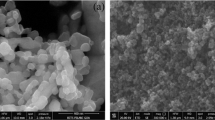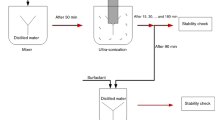Abstract
The most important thermal and rheological properties of water-based CaCO3/SiO2 dual hybrid nanofluid (DHNF) at overall volumetric concentrations of the nanoparticles from 0.1 to 0.5 and different volume fractions at temperatures of 15–60 °C have been studied. Prepared DHNFs consisted using SDS and ultrasonic homogenizer. Stability analysis of the DHNFs performed by changing ultrasonication time and power. The optimum consistency conditions and volume fractions of the nanoparticles determined for the prepared DHNFs. Specific heat capacity, thermal conductivity and resistivity, usual viscosity and density of the DHNFs studied, experimentally, compared with preexisting models, and finally, theoretical models with 99% precisions suggested. Maximum augmentation in thermal conductivity attained to 21.8% for 80:20 corresponding volume ratio and 0.5 vol% total concentration. At these conditions, maximum reduction in heat capacity occurred as 1.08%, and the greatest reduction in thermal resistivity got about 22.2% at 60 °C. Usual viscosity and density increased as 36.9 and 1.2%, respectively.
















Similar content being viewed by others
Abbreviations
- \({C}_{{\text{p}}}\) :
-
Specific heat capacity (Jg−1k−1)
- \(K\) :
-
Thermal conductivity (Wm−1k−1)
- R :
-
Thermal resistivity (m kW−1)
- \(T\) :
-
Temperature (°C)
- \(\rho \) :
-
Density (gcm−3)
- φ :
-
Volume fraction
- μ :
-
Dynamic viscosity (mPa s)
- bf :
-
Base fluid
- nf :
-
Nanofluid
- np :
-
Nanoparticle
- DW:
-
Distilled water
- SDS:
-
Sodium dodecyl sulfate
- DHNFs:
-
Dual Hybrid Nanofluids
References
Lund LA, et al. Magnetohydrodynamic flow of Cu–Fe 3 O 4/H 2 O hybrid nanofluid with effect of viscous dissipation: dual similarity solutions. J Therm Anal Calorim. 2021;143:915–27.
Anwar T, Kumam P, Thounthong P. A comparative fractional study to evaluate thermal performance of NaAlg–MoS2–Co hybrid nanofluid subject to shape factor and dual ramped conditions. Alex Eng J. 2022;61(3):2166–87.
Izady M, et al. Flow of aqueous Fe2O3–CuO hybrid nanofluid over a permeable stretching/shrinking wedge: a development on Falkner-Skan problem. Chin J Phys. 2021;74:406–20.
Waini I, Ishak A, Pop I. Flow and heat transfer along a permeable stretching/shrinking curved surface in a hybrid nanofluid. Phys Scr. 2019;94(10): 105219.
Jamshed W, et al. Computational frame work of Cattaneo-Christov heat flux effects on Engine Oil based Williamson hybrid nanofluids: a Thermal case study. Case Stud Therm Eng. 2021;26: 101179.
Zou Y, et al. Inspiration from a thermosensitive biomass gel: a novel method to improving the stability of core-shell “dry water” fire extinguishing agent. Powder Technol. 2019;356:383–90.
Sarkar J, Ghosh P, Adil A. A review on hybrid nanofluids: recent research, development and applications. Renew Sustain Energy Rev. 2015;43:164–77.
Rostami MN, Dinarvand S, Pop I. Dual solutions for mixed convective stagnation-point flow of an aqueous silica–alumina hybrid nanofluid. Chin J Phys. 2018;56(5):2465–78.
Maddah H, et al. Factorial experimental design for the thermal performance of a double pipe heat exchanger using Al2O3-TiO2 hybrid nanofluid. Int Commun Heat Mass Transf. 2018;97:92–102.
Ho C-J, et al. Water-based suspensions of Al2O3 nanoparticles and MEPCM particles on convection effectiveness in a circular tube. Int J Therm Sci. 2011;50(5):736–48.
Suresh S, et al. Synthesis of Al2O3–Cu/water hybrid nanofluids using two step method and its thermo physical properties. Colloids Surf, A. 2011;388(1–3):41–8.
Botha SS, Ndungu P, Bladergroen BJ. Physicochemical properties of oil-based nanofluids containing hybrid structures of silver nanoparticles supported on silica. Ind Eng Chem Res. 2011;50(6):3071–7.
Baghbanzadeh M, et al. Synthesis of spherical silica/multiwall carbon nanotubes hybrid nanostructures and investigation of thermal conductivity of related nanofluids. Thermochim Acta. 2012;549:87–94.
Esfe MH, et al. Experimental determination of thermal conductivity and dynamic viscosity of Ag–MgO/water hybrid nanofluid. Int Commun Heat Mass Transfer. 2015;66:189–95.
Sheikholeslami M, Hayat T, Alsaedi A. MHD free convection of Al2O3–water nanofluid considering thermal radiation: a numerical study. Int J Heat Mass Transf. 2016;96:513–24.
Kristiawan B, et al. Heat transfer enhancement of TiO2/water nanofluid at laminar and turbulent flows: a numerical approach for evaluating the effect of nanoparticle loadings. Energies. 2018;11(6):1584.
O’Hanley H, et al. Measurement and model validation of nanofluid specific heat capacity with differential scanning calorimetry. Adv Mech Eng. 2012;4: 181079.
Vanapalli S, ter Brake HJ. Assessment of thermal conductivity, viscosity and specific heat of nanofluids in single phase laminar internal forced convection. Int J Heat Mass Transf. 2013;64:689–93.
Ijam A, et al. Stability, thermo-physical properties, and electrical conductivity of graphene oxide-deionized water/ethylene glycol based nanofluid. Int J Heat Mass Transf. 2015;87:92–103.
Soltani O, Akbari M. Effects of temperature and particles concentration on the dynamic viscosity of MgO-MWCNT/ethylene glycol hybrid nanofluid: experimental study. Physica E. 2016;84:564–70.
Azmi W, et al. Heat transfer and friction factor of water based TiO2 and SiO2 nanofluids under turbulent flow in a tube. Int Commun Heat Mass Transfer. 2014;59:30–8.
Bahrami M, et al. An experimental study on rheological behavior of hybrid nanofluids made of iron and copper oxide in a binary mixture of water and ethylene glycol: non-Newtonian behavior. Exp Thermal Fluid Sci. 2016;79:231–7.
Ajeel RK, et al. Assessment and analysis of binary hybrid nanofluid impact on new configurations for curved-corrugated channel. Adv Powder Technol. 2021;32(10):3869–84.
Ajeel RK, et al. Numerical investigation of binary hybrid nanofluid in new configurations for curved-corrugated channel by thermal-hydraulic performance method. Powder Technol. 2021;385:144–59.
Çiftçi E. Distilled water-based AlN+ ZnO binary hybrid nanofluid utilization in a heat pipe and investigation of its effects on performance. Int J Thermophys. 2021;42(3):38.
Kumar V, Sahoo RR. Viscosity and thermal conductivity comparative study for hybrid nanofluid in binary base fluids. Heat Transf Asian Res. 2019;48(7):3144–61.
Vidhya R, Balakrishnan T, Kumar BS. Investigation on thermophysical properties and heat transfer performance of heat pipe charged with binary mixture based ZnO-MgO hybrid nanofluids. Mater Today: Proc. 2021;37:3423–33.
Afshari A, et al. Experimental investigation of rheological behavior of the hybrid nanofluid of MWCNT–alumina/water (80%)–ethylene-glycol (20%) new correlation and margin of deviation. J Therm Anal Calorim. 2018;132:1001–15.
Ahmed M, et al. Numerical and experimental investigations on the heat transfer enhancement in corrugated channels using SiO2–water nanofluid. Case Stud Ther Eng. 2015;6:77–92.
Sundar LS, et al. Hybrid nanofluids preparation, thermal properties, heat transfer and friction factor–a review. Renew Sustain Energy Rev. 2017;68:185–98.
Alktranee M, Bencs P. Factors affecting nanofluids behaviour: a review. Int Rev Appl Sci Eng. 2023;14(2):241–55.
Kumar L, Walvekar R, Khalid M. An overview of recent advancements and applications of hybrid nanofluids. Mater Today Proc. 2023. https://doi.org/10.1016/j.matpr.2023.02.060.
Hamzah MH, et al. Factors affecting the performance of hybrid nanofluids: a comprehensive review. Int J Heat Mass Transf. 2017;115:630–46.
Çolak AB, et al. Experimental study on the specific heat capacity measurement of water-based al2o3-cu hybrid nanofluid by using differential thermal analysis method. Curr Nanosci. 2020;16(6):912–28.
Yang L, et al. Recent developments on viscosity and thermal conductivity of nanofluids. Powder Technol. 2017;317:348–69.
Rashmi W, et al. Stability and thermal conductivity enhancement of carbon nanotube nanofluid using gum arabic. J Exp Nanosci. 2011;6(6):567–79.
Eapen J et al. The classical nature of thermal conduction in nanofluids. 2010.
Aminian A. Predicting the effective viscosity of nanofluids for the augmentation of heat transfer in the process industries. J Mol Liq. 2017;229:300–8.
Zhu D, et al. Intriguingly high thermal conductivity increment for CuO nanowires contained nanofluids with low viscosity. Sci Rep. 2018;8(1):5282.
Yadav D, et al. Density variation in nanofluids as a function of concentration and temperature. Mater Today: Proc. 2021;46:6576–80.
Rajkotwala A, Banerjee J. Influence of rheological behavior of nanofluid on heat transfer. WSEAS Trans Heat Mass Transf. 2013;8:67–81.
Author information
Authors and Affiliations
Corresponding authors
Additional information
Publisher's Note
Springer Nature remains neutral with regard to jurisdictional claims in published maps and institutional affiliations.
Rights and permissions
Springer Nature or its licensor (e.g. a society or other partner) holds exclusive rights to this article under a publishing agreement with the author(s) or other rightsholder(s); author self-archiving of the accepted manuscript version of this article is solely governed by the terms of such publishing agreement and applicable law.
About this article
Cite this article
Mousavi, S.M., Darvishi, P. & Pouranfard, A. Comprehensive study of stability and thermo-physical properties of water-based CaCO3/SiO2 dual hybrid nanofluid. J Therm Anal Calorim 149, 3937–3950 (2024). https://doi.org/10.1007/s10973-024-12976-1
Received:
Accepted:
Published:
Issue Date:
DOI: https://doi.org/10.1007/s10973-024-12976-1




